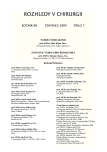Complications of IPOM Plasty – Our Experience
Authors:
F. Fidler; J. Kašík
Authors‘ workplace:
Oddělení všeobecné chirurgie, Nemocnice Na Homolce, Praha, primář: MUDr. František Fidler, CSc.
Published in:
Rozhl. Chir., 2009, roč. 88, č. 7, s. 394-397.
Category:
Monothematic special - Original
Overview
Laparoscopic IPOM (Intraperitoneal Onlay mesh, method of intraperitoneal placement of mesh) hernioplasty, using the artificial mesh and when the method is managed sufficiently, has been used mainly for larger ventral hernias either in linea alba or more for incisional and Spiegel hernias. IPOM hernioplasty were supposed to be the gold standard for these hernioplasties, mainly for their rapidity, total view during operation and good recovery after it. There have been performed these operations also for inguinal hernias at several Surgical departments.
There is a lot of studies proving safety of this method. On the other hand there exist studies pointing out severe postoperative complications of this method. These are both inflammatory and adhesive and they make threat for their long-term manifestation after primary operation and also for every next abdominal operation. We have had patients with both of these complications in our set. Considering this method for hernioplasty, we stopped performing IPOM.
Key words:
IPOM (Intraperitoneal Onlay mesh) – hernioplasty – artificial mesh – complication
Sources
1. Udwadia, T. E. Inguinal hernia repair: The total picture. J. Min. Access Surg. [seriál online] 2006 [cited 2009 Jan 24]; 2: 144–146.
2. Franklin, M. E. Jr., Diaz-Elizondo, J. A. Laparoscopic Intraperitoneal Onlay Mesh Hernia Repair. Lap. Surg. of the Abdomen, 2004, Springer New York, Section V, Part I: 282–287.
3. Kavic, M. S., Creighton University, Laparoscopic hernia repair. A laparoscopic intraperitoneal onlay mesh technique for the repair of an indirect inguinal hernia. Nebraska, Harwood Academie Publishers, 1997: 83–95.
4. Krähenbühl L., Schäfer, M., Feodorovici, M. A., Büchler, M. W. Comparison of TAPP and IPOM method in laparoscopic inguinal hernia repair. Dig. Surg., 1998; 15: 158–166.
5. Czudek, S., Mec, V. Hernia, Abstract Book, 23rd International Congress, Milano, Italy, New method of laparoscopic inguinal hernioplasty – TOM (Transabdominal Onlay mesh), June 2001.
6. Czudek, S., Adamčík, L., Matloch, J., Mec, V., Otaševič, A., Říha, D. Clinical adhesions after laparoscopic hernia repairs is the peritonealisation needed during laparoscopic hernia repairs? Surgical endoscopy, Suppl. to Vol. 18, 2004.
7. Clinge, U. Klosterhalfen, B, Muller, M. Schumpelick, V. Foreign body reaction to meshes used for the repair of abdominal wall hernias. Eur. J. Surg., 1999; 165: 665–667.
8. Kurukahvecioglu, O., Ege, B., Yazicioglu, O., Tezel, E., Ersoy, E. Polytetrafluoroethylene prosthesis migration into the bladder after laparoscopic hernia repair: a case report. Surg. Laparosc. Endosc. Percutan. Tech., 2007, 17, vol. 5: 474–476.
9. Goel, A., Seth, A., Kumar, R. Vesicocutaneous fistula: A rare delayed complication of polypropylene mesh hernioplasty. Indian J. Urol., 2003; 20: 60–6l.
Labels
Surgery Orthopaedics Trauma surgeryArticle was published in
Perspectives in Surgery

2009 Issue 7
Most read in this issue
- Septic Shock in a Patient with the Fourniér Gangrene with Fatal Outcome
- Complications of IPOM Plasty – Our Experience
- The Complication of a Periproctal Abscess – Fourniér’s Gangrene or Necrotizing Fasciitis? A Case Report
- Anti- biotic Prophylaxis in Urology
